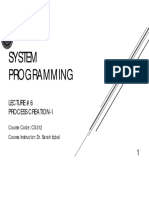4 Process Control Block
Uploaded by
mdhuq14 Process Control Block
Uploaded by
mdhuq1Process Control Block (PCB) - Class Notes
Every process has an address space in user mode and PCB in kernel mode as shown below. User mode address space consists of code segment, data segment, heap and stack.
Stack
Heap
Data segment
Code segment
PCB
PCB is a kernel structure whose instance is created for each process to store process information. PCB is created when the process is loaded and de-allocated when the application is fully terminated Linux kernel uses a structure called task_struct to implement process control block (PCB). This structure can be found in the Linux source code $vim include/linux/sched.h
Important elements of PCB: task_struct contains following Process identification information (PID ,PPID ,CPID ) Process scheduling policy and state Information about number of user level threads mapped to the process. mm_struct gives process address space information tty_struct gives the active terminal information
This is only a supplementary material to classroom sessions
Copyright Veda Solutions (www.techveda.org)
files_struct gives the information about the files which the application currently using. It is called file descriptor table. signal _struct gives the signal information.
Users can see PCB through /proc directory. In order to understand more lets run a simple C file and execute the output. We use a getcar() to put it in a wait state.
Compile and run the above program.
Copyright Veda Solutions (www.techveda.org)
This is only a supplementary material to classroom sessions
Ps -Af is the command used to see the current running process in the kernel. It also shows the PID of the processes. It gives the PID of our program test1
Then go to /proc, there we will find our pid.
Copyright Veda Solutions (www.techveda.org)
This is only a supplementary material to classroom sessions
If we go to our particular pid, it shows task_struct tree as shown below.
In PID directory we can see a file maps, if we execute $cat maps, which shows mm_struct i.e. it shows the addresses for the particular process as shown below. It also shows the addresses of libraries linked to it.
Thus /proc is a directory which shows the process table and addresses mapped to a particular process.
Copyright Veda Solutions (www.techveda.org)
This is only a supplementary material to classroom sessions
You might also like
- Lab 3 Course: Operating Systems: Thanh Le-Hai Hoang Email: Thanhhoang@hcmut - Edu.vnNo ratings yetLab 3 Course: Operating Systems: Thanh Le-Hai Hoang Email: Thanhhoang@hcmut - Edu.vn12 pages
- Operating Systems ECE344: Lecture 3: ProcessesNo ratings yetOperating Systems ECE344: Lecture 3: Processes46 pages
- Process Control Blocks Linux PCBS: Operating Systems Operating Systems 2No ratings yetProcess Control Blocks Linux PCBS: Operating Systems Operating Systems 24 pages
- Process Control Blocks Linux PCBS: Operating Systems Operating Systems 2No ratings yetProcess Control Blocks Linux PCBS: Operating Systems Operating Systems 24 pages
- Processes: Bilkent University Department of Computer Engineering CS342 Operating SystemsNo ratings yetProcesses: Bilkent University Department of Computer Engineering CS342 Operating Systems79 pages
- Chapter 3: Process: COP 4610: Introduction To Operating Systems (Fall 2016)No ratings yetChapter 3: Process: COP 4610: Introduction To Operating Systems (Fall 2016)47 pages
- OS Structure, Processes & Process Management: What Is A Process?No ratings yetOS Structure, Processes & Process Management: What Is A Process?14 pages
- CSE 451: Operating Systems Winter 2012: ProcessesNo ratings yetCSE 451: Operating Systems Winter 2012: Processes14 pages
- OS Structure, Processes & Process ManagementNo ratings yetOS Structure, Processes & Process Management27 pages
- Unix System Kernel: Instructor: S. Kiptoo Computer Science & IT Kimathi University College of TechnologyNo ratings yetUnix System Kernel: Instructor: S. Kiptoo Computer Science & IT Kimathi University College of Technology79 pages
- SIMATIC HMI ProTool Configuring Windows-Based SystemsNo ratings yetSIMATIC HMI ProTool Configuring Windows-Based Systems40 pages
- BIST Using Cellular Automata As Test Pattern Generator and Response CompactionNo ratings yetBIST Using Cellular Automata As Test Pattern Generator and Response Compaction4 pages
- Free Electrons: GR Egory CL Ement, Michael Opdenacker, Maxime Ripard, Thomas Petazzoni Free ElectronsNo ratings yetFree Electrons: GR Egory CL Ement, Michael Opdenacker, Maxime Ripard, Thomas Petazzoni Free Electrons525 pages
- Minimum Spanning Trees: (Some Material Adapted From Slides by Peter Lee)No ratings yetMinimum Spanning Trees: (Some Material Adapted From Slides by Peter Lee)23 pages
- The Role of The Lexical Analyzer: Token Source ProgramNo ratings yetThe Role of The Lexical Analyzer: Token Source Program30 pages
- Deterministic Finite Automata: - A Deterministic Finite Automata (DFA, For Short) Is A Special Case of NDFA in WhichNo ratings yetDeterministic Finite Automata: - A Deterministic Finite Automata (DFA, For Short) Is A Special Case of NDFA in Which33 pages
- Lab 3 Course: Operating Systems: Thanh Le-Hai Hoang Email: Thanhhoang@hcmut - Edu.vnLab 3 Course: Operating Systems: Thanh Le-Hai Hoang Email: Thanhhoang@hcmut - Edu.vn
- Process Control Blocks Linux PCBS: Operating Systems Operating Systems 2Process Control Blocks Linux PCBS: Operating Systems Operating Systems 2
- Process Control Blocks Linux PCBS: Operating Systems Operating Systems 2Process Control Blocks Linux PCBS: Operating Systems Operating Systems 2
- Processes: Bilkent University Department of Computer Engineering CS342 Operating SystemsProcesses: Bilkent University Department of Computer Engineering CS342 Operating Systems
- Chapter 3: Process: COP 4610: Introduction To Operating Systems (Fall 2016)Chapter 3: Process: COP 4610: Introduction To Operating Systems (Fall 2016)
- OS Structure, Processes & Process Management: What Is A Process?OS Structure, Processes & Process Management: What Is A Process?
- Unix System Kernel: Instructor: S. Kiptoo Computer Science & IT Kimathi University College of TechnologyUnix System Kernel: Instructor: S. Kiptoo Computer Science & IT Kimathi University College of Technology
- MVS JCL Utilities Quick Reference, Third EditionFrom EverandMVS JCL Utilities Quick Reference, Third Edition
- SIMATIC HMI ProTool Configuring Windows-Based SystemsSIMATIC HMI ProTool Configuring Windows-Based Systems
- BIST Using Cellular Automata As Test Pattern Generator and Response CompactionBIST Using Cellular Automata As Test Pattern Generator and Response Compaction
- Free Electrons: GR Egory CL Ement, Michael Opdenacker, Maxime Ripard, Thomas Petazzoni Free ElectronsFree Electrons: GR Egory CL Ement, Michael Opdenacker, Maxime Ripard, Thomas Petazzoni Free Electrons
- Minimum Spanning Trees: (Some Material Adapted From Slides by Peter Lee)Minimum Spanning Trees: (Some Material Adapted From Slides by Peter Lee)
- The Role of The Lexical Analyzer: Token Source ProgramThe Role of The Lexical Analyzer: Token Source Program
- Deterministic Finite Automata: - A Deterministic Finite Automata (DFA, For Short) Is A Special Case of NDFA in WhichDeterministic Finite Automata: - A Deterministic Finite Automata (DFA, For Short) Is A Special Case of NDFA in Which




































































